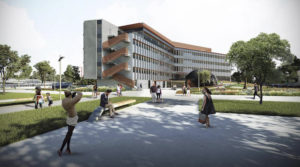CSU Sacramento Science Building to Reflect Educational Design Evolution
SACRAMENTO, Calif. — California State University (CSU), Sacramento is in the process of constructing the new Science II Building, expected for completion in spring 2019. The five-story facility will centralize the College of Natural Sciences’ Biology and Chemistry departments, featuring teaching and research labs, an observatory and a planetarium.

Sundt Construction of Sacramento is serving as the construction manager on the $91 million project, while Los Angeles-based CO Architects is the architect. School Construction News spoke to James Simeo, AIA, LEED AP principal at CO Architects, who has now worked on projects for five University of California campuses, about the evolution of education design.
Q: How many years have you been designing educational facilities, and how has the industry changed since you began?
Simeo: I have devoted my 25-year career to the design and construction of higher education facilities. I decided early on that the most useful application of my architectural training and talent was in expanding educational opportunities to the widest variety of students.
Working relationships between architects, clients and contractors have become much more collaborative over the years. As academic boundaries between departments have become blurred, so have the programs and buildings that we design for our clients. The ever-changing academic landscape has enhanced the architect’s role as mediator and problem solver. In order to fulfill this role effectively, architects must have greater and more in-depth interaction with specific user groups.
Buildings have also become more complex. Architects and contractors are becoming integrated earlier in the design process to share ideas and strategies. There are fewer adversarial relationships between architects and contractors when teaming together earlier and working toward a common end goal for the client. This integrated method of working lends itself to a more enjoyable experience, allows for better information sharing and, eventually, becomes a successful outcome for all parties.
Q: How does the Science II Building at California State University, Sacramento reflect some of these changes?

Simeo: We have been working with Sundt Construction, with whom we have a long and productive relationship, to deliver the 96,000-square-foot Science II Building at CSU Sacramento under the design/build procurement process. This methodology — increasingly requested by our academic clients — is highly collaborative, requiring the contractor and architect to work closely together through the programming and design phases to track cost and optimize client value.
Working closely with a contractor who understands CO Architects’ aesthetic, culture and processes has allowed us to provide a design that addresses campus needs within budget. We may not have been able to consider a more adventurous and distinctive design without the contractor’s budgetary assurances along the way. This partnership minimizes risk to the university while maximizing the project’s functional and aesthetic value.
Q: How has your work with the contractor and subcontractors changed throughout the different phases of the project?
Simeo: In addition to working with the contractor, we had direct contact with subcontractors from the initial stages of the project. This early teaming through the design/build procurement methodology allowed us to tap into a knowledgeable base of subcontractors, who in turn influenced the design of many building aspects from the exterior skin to the interior finishes. As architects, we are learning in real time the financial implications of our design moves and reacting accordingly.
Q: How do you incorporate student feedback into your projects?
Simeo: CO Architects is committed to providing solutions to our clients’ needs, and every project begins with practical input from the ultimate users of the buildings. We begin our process with conversations among all college and university constituencies — students, faculty, researchers and administrators — so that the end product brings the academic community closer together.
Q: Where do you see the direction of educational design going in the next five to 10 years?
Simeo: It has been wonderful to see student populations become more diverse. As campuses strive to meet multicultural needs, this pattern of diversity will be reflected in the buildings that we program and build. This diversification movement parallels the trend in higher education of greater integration among faculty and researchers across disciplines to solve the multifaceted problems facing society.
The flip side to the idea of constructing new buildings on college campuses is the idea that online coursework will decrease the need for physical buildings. I continue to believe, however, that there is no replacement for the real-world exchange of ideas that a well-planned campus permits, and I hope that colleges and universities will remain laboratories for growth and learning through personal connections and experiences.

